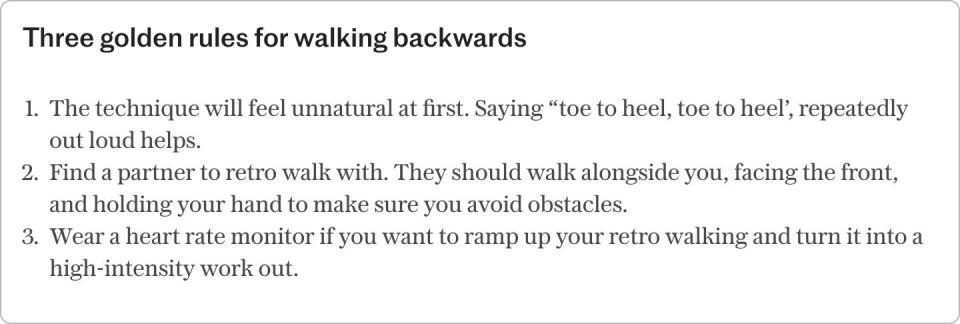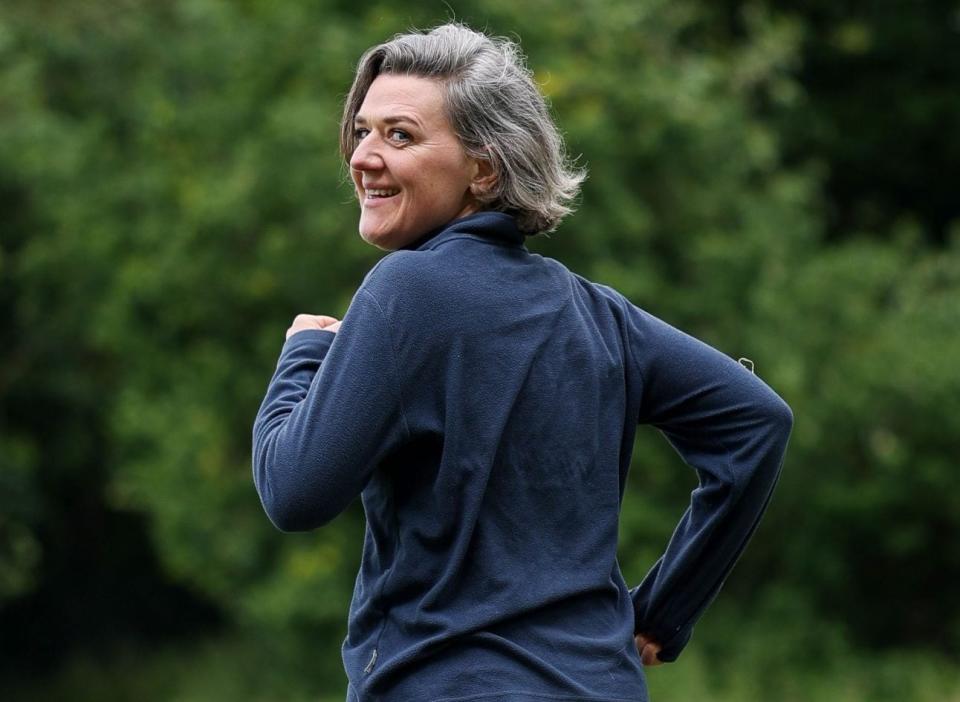Don’t knock it – walking backwards is an exhilarating workout

I’ve been walking, predominantly forwards, since my first birthday party (always one for a deadline). However, a recent social media post from a “fitfluencer” I follow opened my eyes, and ankles, to the benefits of retro walking. Or, to put it in layman’s terms, walking backwards. Intrigued, I consulted an expert.
Studies have shown it can help relieve back pain, is an effective treatment for those with knee problems and can soothe symptoms of arthritis.
“Walking backward challenges your balance and coordination more than walking forward,” says Nailson Jose do Patrocinio, a health and fitness adviser at Oxford Brookes University. “I always make sure that all my clients incorporate this routine into their regimen. Regular practice can lead to significant improvements in overall fitness.”
I am in the gym, beside Nailson, as he very deliberately places knee over toe, knee over toe, moving backwards across the floor. At nearly 60, he is in amazing shape. If retro walking gives me that sort of muscle tone in 20 years, I think, then I’d be more than willing to give it a stumbling chance.
The French athlete Guillaume de Lustrac ran an entire marathon backwards in just 3hrs 25mins last year, while many athletes – particularly in racquet sports – include backwards running as part of their training. But you’ve got to learn to run before you can walk, so I began the session not with a swift backwards 5km but standing on a treadmill.
The technique
“You don’t need to switch the treadmill on,” says Nailson, taking his spot on the machine beside me. “Just push it with your feet.” With my back against the cushioned handrail, I lean into the movement, nudging the belt forward with my heel as my other leg lengthens behind me.
It may sound obvious but foot placement when walking backwards is even more important than when going the old-fashioned way. “Toe to heel, toe to heel,” Nailson repeats as I try, without looking, to imagine the shape my foot is making. Unlike forward gait – in which the heel lands first, followed by the toe – backwards walking means you land on your toes, which puts less strain on your knee joint and activates a different set of leg muscles.

It also takes a surprising amount of concentration. “This enhances proprioception, which is your body’s ability to sense its position in space,” Nailson explains, when I mention how hard I’m having to think about where I’m stepping. “That improved awareness can help prevent falls, injuries and improve your overall stability.”
How it works your muscles
Squats, lunges and deadlifts, while all pivotal parts of a workout, exercise your leg muscles in a largely similar way. But walking backwards is different. “The calves, hamstrings, and glutes are activated more intensely,” Nailson tells me, as I feel a new activation in my backside. “This can help address muscle imbalances.”
Research led by Janet Dufek, a biomechanics expert at the University of Nevada, who has been researching the benefits of walking backwards for more than 20 years, found that just 10-15 minutes of walking backwards daily over four weeks can increase hamstring flexibility.
I also notice that after just a few minutes my core is feeling tighter, more engaged. “Yes!” Nailson enthuses. “It’s cardio, it’s burning calories but you also have to use your abs, your back; it’s good for your posture.” Another study by the team at the University of Nevada found periods of backwards backwards walking reduced lower back pain in athletes.

As someone who has the unconscious posture of a cheese quaver, after years of sitting at desks and bending over a small child, this is welcome news. But can it really burn that many calories, I ask? After all, it’s only walking. Studies show that walking backwards uses 30 per cent more energy. Nailson whips out his phone and shows me the results from his heart monitor from the day before; 30 minutes of retro walking combined with sled training resulted in 421 calories burnt, all while minimising the strain on his knees, and hips. As a result, backward walking is often used in rehabilitation settings, Nailson tells me. “It aids in recovery from injuries because it’s a gentle movement, it engages your muscle, but it’s not an excessive strain.”
Ramping up your retro-walk while protecting your joints
“Let’s see how you get along with this,” says Nailson, taking me through a long, carpeted corridor with a weights sled at one end. “Pulling the sled like this,” he starts walking backwards, pulling the sled with his arms in a locked position, “shortens your hamstrings, glutes, and back muscles”.
I give it a go and again, I am surprised by just how much attention it takes to walk backwards, without tripping over my own feet or losing my nerve. The immediate tautness in my buttocks and stomach is noticeable; and very different to the feeling when I push the sledge forward. “This puts less stress on joints than traditional weightlifting,” explains Nailson, who uses the technique with some clients who are in their 60s and 70s.
‘Training at this level enhances endurance and performance, allowing for high-intensity exercise without rapid fatigue. Depending on your training goals, different heart rate zones can be targeted. For instance, the fat-burning zone is typically around 60-70 per cent of your maximum heart rate, which is ideal for weight loss and improving basic endurance. The aerobic zone, at 70-80 per cent, focuses on cardiovascular fitness and stamina. Training just below the lactate threshold, around 85-90 per cent of your maximum heart rate, is optimal for improving performance and endurance, as it allows you to exercise intensely without quickly fatiguing.”
Retro-walking in the wild
The next day, inspired by my gym session, I try a little bit of retro walking in the wild. Running backwards is usually done with a partner – someone who runs alongside you, facing front, and holding your hand to make sure you avoid obstacles. However, it’s early and nobody wants to join me. So I trot gently backwards along the towpath for a few metres, bathed in a hazy green light, looking over my shoulder every few seconds to make sure I’m not about to plop straight into the Thames.

I feel my posture improving, my core engaged. My pace is slower but my stride is bouncier, my landing more considered. I can absolutely see how this would save your joints the usual concrete-pounding impact of a forwards run. Until I notice a bike coming towards me. The cyclist has plenty of room to overtake but seems to be caught somewhere between confusion and bursting out laughing. I suddenly realise what I must look like; a 39-year-old woman, alone, at the crack of dawn, reversing down the towpath like a runaway bin lorry.
Feeling self-conscious, I quickly turn around and pick up my pace. Perhaps this is one best kept to the treadmill.

 Yahoo News
Yahoo News 
